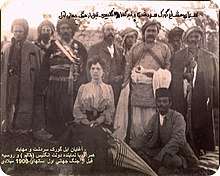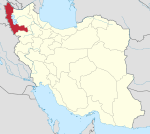Sardasht, West Azerbaijan
Sardasht (Persian: سردشت; Kurdish: سهردهشت, Serdeşt; also Romanized as Sar Dasht)[2] is a city in and the capital of Sardasht County, West Azerbaijan Province, Iran. At the 2006 census, its population was 68165, in 8,224 families.[3]
Sardasht سردشت | |
|---|---|
City | |
 Square in Sardasht | |
 Sardasht | |
| Coordinates: 36°09′19″N 45°28′44″E | |
| Country | |
| Province | West Azerbaijan |
| County | Sardasht |
| Bakhsh | Central |
| Elevation | 1,480 m (4,860 ft) |
| Population (2016 Census) | |
| • Total | 68,165[1] |
| Time zone | UTC+3:30 (IRST) |
| • Summer (DST) | UTC+4:30 (IRDT) |
Sardasht is located southwest of Lake Urmia about 1,480 metres above sea level. It lies in the West Azerbaijan province.
Sardasht, far from the frontline, was notably attacked with chemical weapons by Iraqi forces under Saddam Hussein during the Iran–Iraq War. It was the first deliberate chemical attack against Iranian civilians.
Kurds are the dominant ethnicity in Sardasht.[4] Sardasht is also known for the many villages around it and their reliance on the city's market.

Etymology
A popular belief is that Sardasht (or Zardasht) comes from the Kurdish word for Zoroaster.[5] Sardasht can also be split into two words: sar and dasht. Meaning plains that extend all the way to a river.[6]
History
Pre–Islamic era
In pre–Islamic times, Sardasht was located to the northwest of its current location and was close to a large spring. The city was also called Nizerou and had five towers. Sardasht is a historical area with a selection of ancient pre–Islamic sites still present today. Near Sardasht there is a castle which dates back to the Parthian Empire.[7]
1987 attacks on Sardasht with chemical weapons
On June 28, 1987, Iraqi aircraft dropped what Iranian authorities believed to be mustard gas bombs on Sardasht, in two separate bombing runs on four residential areas. The numbers of victims were initially estimated as 10 civilians dead and 650 civilians injured.[8]
Out of a population of 20,000, 25% are still suffering severe illnesses from the attacks.[9] The gas attacks occurred during the Iran–Iraq War, when Iraq frequently used chemical weapons against Iranian civilians and soldiers.
In April 2004, the government of the United States (US) was found by the Tehran Public Court to be liable for the attacks, through its previous support for the government of Saddam Hussein. The US government was ordered to pay $600 million compensation to the victims.[10]
Because Sardasht was not considered a military target, the population was both unprotected and unprepared for a chemical weapons assault. Living close to the border and to the war front, citizens had become accustomed to Iraqi bombardment with conventional weapons. However, people later told physicians that they did not know that the bombs carried chemical weapons; in fact, at first they had been relieved when the bombs did not explode.
Due to the direction of the wind, even the hospital and the convalescent center were contaminated, and the few doctors and nurses who were working there had to leave. Two public baths were used for decontamination of the victims and a small stadium was converted to a 150-bed medical facility. Within the first few hours, about 30 people died, mostly young children and old people, due to severe respiratory problems.
Out of 12,000 inhabitants, according to official reports, 8,000 were exposed. Of the 4,500 requiring medical care, 1,500 were hospitalized, 600 of them in Tehran. The other 3,000 were treated as outpatients and discharged. Many of these 3,000 former outpatients left the city for the villages and attempted to treat themselves, using traditional medicines, etc. These people do not have medical records of their exposure and now are having difficulty obtaining government benefits.
Included among the 4,500 casualties requiring medical attention were some of the rescuers.[11]
Casualties up until 2007: altogether 130 people (109 civilians, 21 military and other) have died from the sulfur mustard attack on Sardasht in June 1987. Twenty people died in the first few hours, ten during the evacuation to other cities, and about one hundred more died in hospitals in Iran and Europe during the next month. Of the civilians who died, 39 were under 18 years of age, including 11 under the age of 5. Thirty-four women and girls died.[12][13]
Mustard is not considered a lethal agent, but an incapacitating agent, causing only 3-5% mortality. Many of the 95% who survived from the Sardasht gas attack, developed serious long-term complications over the next few years including serious respiratory problems, eye lesions, skin problems as well as problems in their immune system.[14][15]
Iran–PJAK conflict
Sardasht and its surrounding areas became a scene of sporadic clashes between Iranian IRGC forces and the militant Kurdish PJAK organization. Among those clashes was the August 2013 Sardasht clash.
Climate
| Climate data for Sardasht, Āzarbāijān-e Gharbī | |||||||||||||
|---|---|---|---|---|---|---|---|---|---|---|---|---|---|
| Month | Jan | Feb | Mar | Apr | May | Jun | Jul | Aug | Sep | Oct | Nov | Dec | Year |
| Record high °C (°F) | 16 (61) |
13.8 (56.8) |
21.1 (70.0) |
27.2 (81.0) |
32.0 (89.6) |
35.2 (95.4) |
39.6 (103.3) |
38.2 (100.8) |
34.4 (93.9) |
29.6 (85.3) |
20.0 (68.0) |
18.0 (64.4) |
39.6 (103.3) |
| Average high °C (°F) | 1.2 (34.2) |
2.3 (36.1) |
7.6 (45.7) |
14.8 (58.6) |
20.5 (68.9) |
27.0 (80.6) |
31.2 (88.2) |
31.0 (87.8) |
26.6 (79.9) |
19.4 (66.9) |
10.4 (50.7) |
4.8 (40.6) |
16.40 (61.52) |
| Average low °C (°F) | −3.5 (25.7) |
−3.1 (26.4) |
1.3 (34.3) |
7.1 (44.8) |
11.8 (53.2) |
17.4 (63.3) |
21.2 (70.2) |
20.8 (69.4) |
17.1 (62.8) |
11.5 (52.7) |
4.3 (39.7) |
−0.5 (31.1) |
8.78 (47.80) |
| Record low °C (°F) | −25 (−13) |
−19.6 (−3.3) |
−16.6 (2.1) |
−2.4 (27.7) |
−1.8 (28.8) |
7.8 (46.0) |
13.0 (55.4) |
11.4 (52.5) |
5.8 (42.4) |
2.6 (36.7) |
−9.2 (15.4) |
−12.8 (9.0) |
−25 (−13) |
| Average precipitation mm (inches) | 134.6 (5.30) |
108.3 (4.26) |
128.2 (5.05) |
124.3 (4.89) |
50.7 (2.00) |
4.8 (0.19) |
1.8 (0.07) |
1.1 (0.04) |
2.8 (0.11) |
41.4 (1.63) |
118.5 (4.67) |
149.5 (5.89) |
866 (34.1) |
| Average precipitation days (≥ 1.0 mm) | 11.3 | 9.9 | 10.8 | 10.1 | 5.9 | 1.1 | 0.5 | 0.4 | 0.7 | 4.7 | 7.8 | 10.2 | 73.4 |
| Average relative humidity (%) | 73 | 68 | 62 | 54 | 44 | 31 | 31 | 29 | 29 | 44 | 59 | 68 | 49 |
| Mean monthly sunshine hours | 133.0 | 138.4 | 184.0 | 219.2 | 288.3 | 352.8 | 367.7 | 357.5 | 312.0 | 248.0 | 180.7 | 129.8 | 2,911.4 |
| Source: Synoptic Stations Statistics | |||||||||||||
See also
- Chemical warfare
- Chemical bombing of sardasht
References
- "Statistical Center of Iran > Home".
- Sardasht, West Azerbaijan can be found at GEOnet Names Server, at this link, by opening the Advanced Search box, entering "-3082687" in the "Unique Feature Id" form, and clicking on "Search Database".
- "Census of the Islamic Republic of Iran, 1395 (2016)" (Excel). Islamic Republic of Iran.
- https://anfpersian.com/znn/مرگ-ناخواسته-یک-دختر-کرد-در-سردشت-39362
- "Archived copy". Archived from the original on 2014-11-29. Retrieved 2015-02-04.CS1 maint: archived copy as title (link)
- "Archived copy". Archived from the original on 2014-11-29. Retrieved 2015-02-04.CS1 maint: archived copy as title (link)
- "Archived copy". Archived from the original on 2014-11-29. Retrieved 2015-02-04.CS1 maint: archived copy as title (link)
- "Iran Profile - Chemical Chronology 1987". Nuclear Threat Initiative. October 2003. Archived from the original on 2007-04-16. Retrieved 2007-07-01.
- Iranian Chemical Attacks Victims
- "Iran: Tehran's Public Court issues $600 million verdict against US to pay to Sardasht residents". Payvand. 2004-04-28. Retrieved 2007-07-01.
- Foroutan, Abbas. Medical Review of Iraqi Chemical Warfare. Tehran, Iran: Baqiyatallah University of Medical Sciences, 2003, p. 183
- Khateri S, Wangerin R. Denied Truths, the story of victims of chemical weapons in Iran, center for women and family affairs. 2008 , ISBN 978-600-5201-13-0
- Khateri S. Victims of chemical weapons in Iran – an evaluation on health status of 45,000 Iranian victims of chemical warfare agents. Society for Chemical Weapons Victims Support (SCWVS) (www.scwvs.org), April 2003, ISBN 964-93602-5-5
- Khateri S, Ghanei M, Soroush MR, Haines D. Effects of mustard gas exposure in paediatric patients. Long-term health status of mustard-exposed children, 14 years after chemical bombardment of Sardasht. J Burns & Wound Care [serial online] (http://www.journalofburnsandwounds.com), 2003;2(1):11
- Ghanei M, Aslani J, Khateri S, Hamadanizadeh K. Public Health Status of the Civil Population of Sardasht 15 Years Following Large−Scale Wartime Exposure to Sulfur Mustard. J Burns &Surg Wound Care [serial online] 2003;2(1):7. Available from: URL: http://www.journalofburns.com . Published March 11, 2003
External links
| Wikimedia Commons has media related to Sardasht. |
